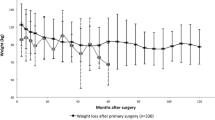Abstract
Purpose
Laparoscopic adjustable gastric banding (LAGB) has declined in popularity due to poor weight loss and high revision rates. The study aim was to evaluate complication rates following LAGB removals, including conversions to other bariatric procedures.
Materials and Methods
This was a retrospective cohort study of patients who underwent LAGB removal, identified from the Metabolic and Bariatric Surgery Accreditation and Quality Improvement Program (MBSAQIP) database from the Toronto Western Hospital site. Patients were filtered using principal procedure and concurrent procedural terminology (CPT) codes. Patients converted to other bariatric procedures were also included. Outcomes were evaluated for 30-day morbidity, mortality, readmissions, and costs.
Results
From 2012 to 2018, 93 patients met inclusion. 96.77% had elective surgery, and 3.23% were emergent. Thirty-day postoperative complication rate was 11.83%, with 4.30% readmissions and no deaths. Surgical site infections accounted for 81.82% of complications (54.55% superficial, 27.27% deep). Thirty-day complication rate for LAGB removal alone was 17.50% and 33.33% following emergent explantation. 56.99% LAGBs were converted to other bariatric procedures: 48.39% laparoscopic Roux-en-Y gastric bypass (LRYGB) and 8.6% sleeve gastrectomy (LSG). Conversion to LSG had a significantly higher 30-day complication rate (all Clavien–Dindo class I–II) compared to conversion to LRYGB (37.50% versus 2.22%, p < 0.009). Direct costs of LAGB explantation to the healthcare system were $665,443, amounting to $7,155 per patient.
Conclusion
Thirty-day complication rates for LAGB explantation and conversion to other bariatric procedures are significant and may be higher than previously reported for LAGB removal alone. Conversion to LSG may have the highest complication rate, amounting to significant costs.
Graphical abstract


Similar content being viewed by others
References
Tice JA, Karliner L, Walsh J, et al. Gastric banding or bypass? A systematic review comparing the two most popular bariatric procedures. Am J Med. 2008;121(10):885–93.
Jackson TD, Saleh F, Quereshy FA, et al. Short-term morbidity associated with removal and revision of the laparoscopic adjustable gastric band. Surg Obes Relat Dis. 2014;10(6):1110–5.
Ibrahim AM, Thumma JR, Dimick JB. Reoperation and Medicare expenditures after laparoscopic gastric band surgery. JAMA Surg. 2017;152(9):835–42.
Arapis K, Tammaro P, Parenti LR, et al. Long-term results after laparoscopic adjustable gastric banding for morbid obesity: 18-year follow-up in a single university unit. Obes Surg. 2017;27(3):630–40.
Prabhu KL, Okrainec A, Maeda A, et al. Utilization of public system for gastric bands placed by private providers: a 4-year population-based analysis in Ontario. Canada Obes Surg. 2018;28(9):2979–82.
Sharma AM. Inequalities in access to bariatric surgery in Canada. CMAJ. 2016;188(5):317–8.
Koh CY, Inaba CS, Sujatha-Bhaskar S, et al. Laparoscopic adjustable gastric band explantation and implantation at academic centers. J Am Coll Surg. 2017;225(4):532–7.
Sharples AJ, Charalampakis V, Daskalakis M, et al. Systematic review and meta-analysis of outcomes after revisional bariatric surgery following a failed adjustable gastric band. Obes Surg. 2017;27(10):2522–36.
Zadeh J, Le C, Ben-David K. Safety of adjustable gastric band conversion surgery: a systematic review and meta-analysis of the leak rate in 1- and 2-stage procedures. Surg Obes Relat Dis. 2020;16(3):437–44.
Aarts E, Koehestanie P, Dogan K, et al. Revisional surgery after failed gastric banding: results of one-stage conversion to RYGB in 195 patients. Surg Obes Relat Dis. 2014;10(6):1077–83.
Anvari M, Lemus R, Breau R. A landscape of bariatric surgery in Canada: for the treatment of obesity, type 2 diabetes and other comorbidities in adults. Can J Diabetes. 2018;42(5):560–7.
Berende CAS, de Zoete J-P, Smulders JF, et al. Laparoscopic sleeve gastrectomy feasible for bariatric revision surgery. Obes Surg. 2012;22(2):330–4.
Park YH, Kim SM. Laparoscopic sleeve gastrectomy as revisional surgery for adjustable gastric band erosion. J Laparoendosc Adv Surg Tech A. 2014;24(9):593–600.
Siegel KR, Ali MK, Zhou X, et al. Cost-effectiveness of interventions to manage diabetes: has the evidence changed since 2008? Diabetes Care. 2020;43(7):1557–92.
Le Coq B, Frering V, Ghunaim M, Campan P, Dabrowski A, Mulliez E, et al. Impact of surgical technique on long-term complication rate after laparoscopic adjustable gastric banding (LAGB): results of a single-blinded randomized controlled trial (ANOSEAN Study). Ann Surg. 2016;264(5):738–44.
Author information
Authors and Affiliations
Corresponding author
Ethics declarations
Ethics Approval
This article does not contain any studies with human participants or animals performed by any of the authors.
Consent to Participate
This is a retrospective cohort study of medical record data. Informed consent does not apply.
Conflict of Interest
The authors declare no competing interests.
Additional information
Publisher's Note
Springer Nature remains neutral with regard to jurisdictional claims in published maps and institutional affiliations.
Key Points
• Thirty-day complication rate following LAGB explantation was 11.83%.
• Conversion to LSG had the highest rate of complications.
• LAGB explantation cost our healthcare 7 K without complications and 13 K with complications, per patient.
Rights and permissions
About this article
Cite this article
Stogryn, S., Johnson, G.G.R.J., Okrainec, A. et al. Outcomes from Explantation of Laparoscopic Adjustable Gastric Band: Experience from a Canadian Bariatric Center of Excellence. OBES SURG 31, 4933–4938 (2021). https://doi.org/10.1007/s11695-021-05676-4
Received:
Revised:
Accepted:
Published:
Issue Date:
DOI: https://doi.org/10.1007/s11695-021-05676-4




